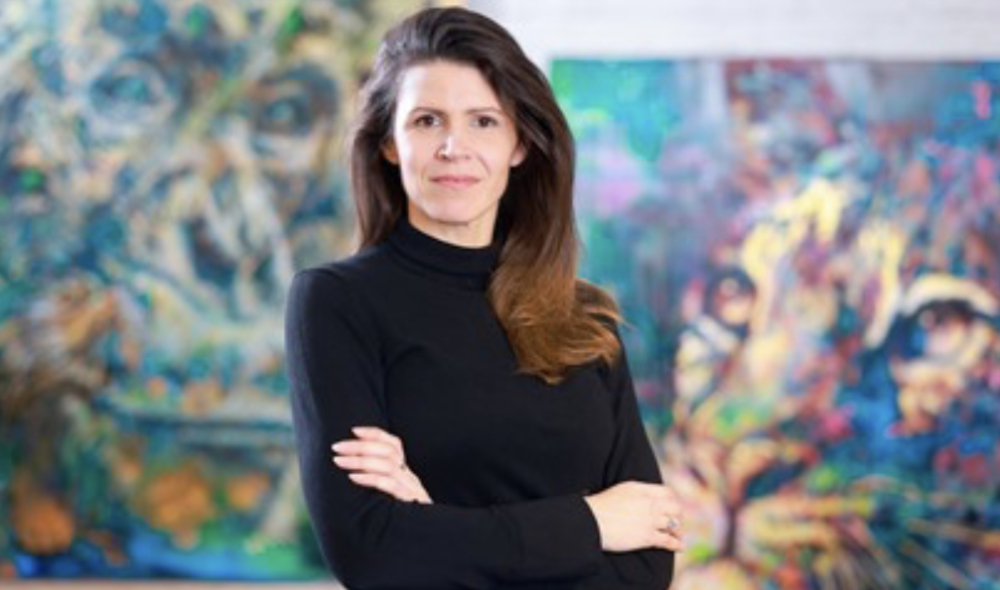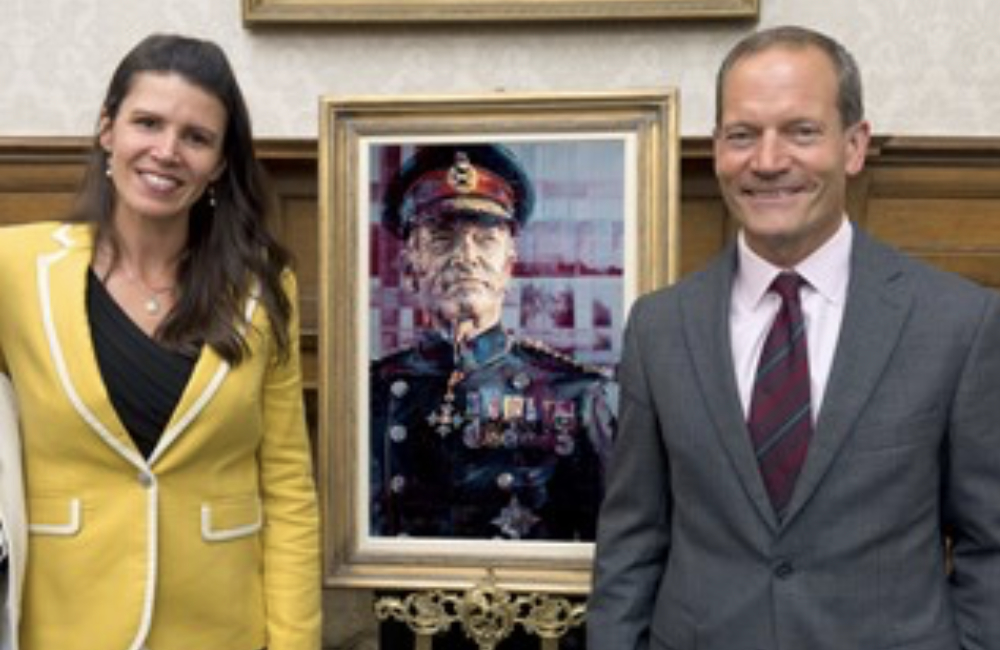Q and A with an artist, philanthropist and ex-Army helicopter pilot
[edit] Q and A with Hannah Shergold - Artist, philanthropist and ex-Army helicopter pilot
Hannah Shergold is a Cambridge zoology graduate, a sculptor, and an ex-military helicopter pilot who, having left the Regular Army in 2018, has become one of the most successful self-representing artists in the UK. Her work has been bought by collectors all over the world and at the time of interviewing she has raised over £350,000 through the donation of her own art. She is an ambassador for Tusk, Prince William’s African conservation charity, and still serves with the Army Reserves delivering training.
A recent military portrait commission project was for the portrait of Lt General Sir Tyrone Urch KBE FICE, a former APM Award winner, having received the Outstanding Achievement Award in 2020 for his work during the COVID-19 pandemic.
Here we speak to Hannah about her career, her motivations, her latest project and plans for the future.
[edit] You’ve had an incredibly varied career so far, but the latest career change from Army to Artist is probably the most unusual. What made you most nervous about this particular switch?
There’s no doubt about it, there’s a lot to be said for having a salary. In fact, the reason I had joined the Army in the first place was because my previous attempt at being a self-employed artist had run straight into the 2008 credit crunch and hadn’t survived. It was devastating.
But this time I had an entirely new skill set. Yes, I could paint, but what really mattered was that I could plan, I could project manage, I could budget, I could communicate effectively… all for large-scale missions and tasks. This time I could ‘do business’.
[edit] What prompted you to make such a bold career change?
I’d had a wonderful career in the Army - a year of Sandhurst, a tour of Afghanistan with the Infantry, then serving all over the world in my role as a frontline pilot and finishing as a ground school tactics instructor - but I’ll be honest I was becoming a little bored. That’s a dangerous place to be, particularly for a pilot. Boredom can compromise safety and you risk a serious accident. As it happened though, my last flying tour was when the art career began to take off.
I was stationed in Kenya on medevac duties flying critically injured soldiers from the desert training areas down to the hospital in Nairobi. The flying was, challenging very intense and hugely rewarding – we really did save lives – but there was plenty of time on standby waiting for a shout. As a way to pass the time I would paint or sketch purely for fun, and ended up hosting a little exhibition out there which was really successful.
When I returned to the UK I was still adamant I wasn’t going to be a full-time artist. I’d been there, done that, got the failure t-shirt. But slowly slowly, the art kept selling, the demand grew, the prices crept up until it was pretty much matching my Army salary. I was essentially working two jobs, one of which was paying the mortgage, so I had the ability to decline any commission work that wasn’t authentic to the type of art I wanted to create.
[edit] How did the project come about to paint the portrait of Lieutenant General Sir Tyrone Urch KBE FICE?
It was a huge honour to be selected by General Urch to paint his portrait, marking the end of his tenure as Chief Royal Engineer and an illustrious career in the British Army.
I met General Urch during the 2018 Invictus Games in Sydney, Australia, where I'd been selected as UK Team artist. He attended the preview of my solo exhibition on London's Pall Mall the following year and pretty much held me to the 2019 pricing!
I must say a huge thank you to General Urch and to the Royal Engineers for the deliberate step away from the traditional style that adorned the Mess. The pose, the framing and the fact that it is (I hope) a likeness all aim to offset the contemporary use of colour and the hint of abstraction. To my great relief, it was a hit! It was a fantastic project to work on.
[edit] What does it take to be successful as a self-representing artist?
Firstly, if you don’t want to give away a 50% commission fee that most galleries will charge, you have to be prepared to do everything that a gallery would (or should) do yourself. That means that if you intend to exhibit, you have to provide a venue, you need to plan and host the preview event, general logistics and not to mention the marketing and PR campaign that can be the make or break of a show.
You have to learn new software for web design and catalogue formatting, understand at least the basics of account management for a Limited Company. You need to network – building relationships with existing and potential clients and sponsors. You need to understand your audience, your own intentions and your plan. None of this is easy, particularly if it’s not your natural skill set, and most artists hate the business part with a passion. Fortunately, though, the ‘sciencey’ side of my brain quite likes it.
Financially it’s very high risk, especially given the fact I underwrite the exhibition before I’ve painted a single piece for the new collection. But I pay zero commission on sales so it’s also very high reward. It also gives me the financial flexibility to pursue the ‘alternative’ opportunities, for example pop-up exhibitions or partnering with charities.
[edit] Do you ever need to draw on your Army skills in your current role?
All the time, but perhaps not in the way that is most obvious. High standards and the ability to plan efficiently and budget well are important, but it’s the leadership skills that are crucial for the large projects. Running the big, high-profile shows on The Mall requires delegation – which I’m rubbish at by the way, but I’ve had to learn it – and those people you delegate to must be as invested in the project as you can possibly make them.
From my framers to my event coordinator, my publicist, my accountant, the staff at Tusk… they all need to understand the goal, but this can be difficult when they themselves have no financial or reputational risk. Therefore, there comes a point where you have to let them in and be vulnerable. The cool, calm, collected project leader must sometimes give an insight into just how much is at stake, whilst also motivating the team to bring their A-game and truly maximise the potential of such a show.
This aspect is no different to the Armed Forces. No matter how much a particular individual or team has been involved in the Operation to date, it’s vital that they understand the overall aim. You can then offer a level of freedom to perform their role in a way that you yourself may not have considered.
[edit] What’s the plan for the future?
I’ve got some fascinating high-profile bespoke projects in the pipeline, and summer 2024 should see another solo exhibition, but actually the plan has always been to not plan too much. This is a mantra I try to live by, and whilst the lack of business plan would be catastrophic if I relied on outside investment or lending, I find the flexibility is a big win.
The 2018 Invictus Games in Sydney, competing in Sky Arts Portrait Artist of the Year, pop-up exhibitions… all these have been short-notice opportunities that I’ve been able to jump on because I’m not fixed on a plan. My Winchester pop-up was planned in the space of two weeks using a vacant shop in prime central Winchester, right in the post-lockdown Christmas shopping buzz of 2020. That show alone produced two new clients whose bespoke commissions formed over a third of my next year’s revenue. Sometimes you’ve just got to go with your gut!
For more information visit Hannah’s website: www.hannahshergold.com
This article appears on the APM news and blog site as "Q&A with Hannah Shergold - Artist, philanthropist and ex-Army helicopter pilot" dated November 27. 2023.
--Association for Project Management
[edit] Related articles on Designing Buildings.
- Art of Building exhibition opens in China.
- Guest editor articles.
- Interview with Paul Grundy - Architectural Photographer.
- Kempe: the life, art and legacy of Charles Eamer Kempe.
- Lillehammer Art Museum and Cinema.
- Masters of their Craft: the art, architecture and garden design of the Nesfields
- Owen Hatherley interview.
- Skyscrapers, staircases and optical illusions - the Art of Building is back.
- Storytelling and the art of communicating archaeology.
- Masters of their Craft: the art, architecture and garden design of the Nesfields.
Featured articles and news
The UK's Modern Industrial Strategy: A 10 year plan
Previous consultation criticism, current key elements and general support with some persisting reservations.
Building Safety Regulator reforms
New roles, new staff and a new fast track service pave the way for a single construction regulator.
Architectural Technologist CPDs and Communications
CIAT CPD… and how you can do it!
Cooling centres and cool spaces
Managing extreme heat in cities by directing the public to places for heat stress relief and water sources.
Winter gardens: A brief history and warm variations
Extending the season with glass in different forms and terms.
Restoring Great Yarmouth's Winter Gardens
Transforming one of the least sustainable constructions imaginable.
Construction Skills Mission Board launch sector drive
Newly formed government and industry collaboration set strategy for recruiting an additional 100,000 construction workers a year.
New Architects Code comes into effect in September 2025
ARB Architects Code of Conduct and Practice available with ongoing consultation regarding guidance.
Welsh Skills Body (Medr) launches ambitious plan
The new skills body brings together funding and regulation of tertiary education and research for the devolved nation.
Paul Gandy FCIOB announced as next CIOB President
Former Tilbury Douglas CEO takes helm.
UK Infrastructure: A 10 Year Strategy. In brief with reactions
With the National Infrastructure and Service Transformation Authority (NISTA).
Ebenezer Howard: inventor of the garden city. Book review.
The Grenfell Tower fire, eight years on
A time to pause and reflect as Dubai tower block fire reported just before anniversary.
Airtightness Topic Guide BSRIA TG 27/2025
Explaining the basics of airtightness, what it is, why it's important, when it's required and how it's carried out.
Construction contract awards hit lowest point of 2025
Plummeting for second consecutive month, intensifying concerns for housing and infrastructure goals.
Understanding Mental Health in the Built Environment 2025
Examining the state of mental health in construction, shedding light on levels of stress, anxiety and depression.
























